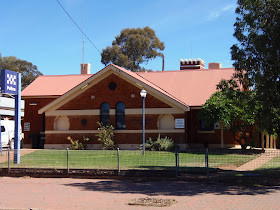I am here for two days so I might as well have a look a around. I have over inflated the leaking tyre and hope it will last until Monday.
Entering Cobar the first thing that cannot be missed is the large sign (with an adjoining Rest Stop I noted), a Miner's Memorial Park and the "Great Cobar Heritage Centre".
Cobar is now a big Town by outback standards with a population quoted as 5500 with Mining, Farming and Tourism the main commercial focus. The Cobar district was the traditional home of the Ngemba and Wongaibon Aboriginal people. Prior to the discovery of Copper in 1870, the district was made up of huge Pastoral Holdings which relied heavily on the Darling River trade.
In 1870, three Tank Sinkers, Charles Campbell, Thomas Hartman and George Gibb accompanied by two Aboriginal guide, Boney and Frank whilst travelling from Bourke to Condobolin stopped at "Kubbur" waterhole near Cobar. The noticed the unusual colour of the water. They took ore samples and showed them to Mr and Mrs Kruge, the proprietors of Gilgunnia Pub. Mrs Kruge had worked in a Copper Mine in the UK and identified the ore as Copper. This discovery lead to the formation of The Great Cobar Copper Mine soon to become the largest copper mine in Australia. At it's peak in 1912, The Mine had 64 Smelters, a 64 metre Chimney stack and employed 2000 people. Despite many profitable years Mine's fortunes crashed when demand for Copper dropped following WW1. and was closed in 1919. The Town's population dwindled from 10,000 at it's peak to 1000 and many small supporting small Towns almost disappeared. Other Mines of Cobar and districts included the New Occidental Gold Mine. 1934 - 1950s kms from Cobar. With new technology Peak Gold Mines has resumed mining at the old site again as well as open cutting the New Cobar site at Fort Bourke Hill; The Cornish, Scottish and Australia Mine (CSA) is a Copper Mine and has operated from 1870s - 1920 when a fire broke out underground and burned for 16 years, again from 1965 - 1998 and again fully operational today; The Endeavour Mine, 45 kms from Cobar opened in 1962 produces Silver, Lead and Zinc; Peak Gold Mines 12 kms Sth of Town opened in 1992 and continues to source Gold deposits.
The Great Cobar Heritage Centre was built in 1910 as the Administration Office for the Great Cobar Copper Mine. Today it is the Town's Heritage Museum. At $10 entry too expensive for me however I did find a way to sneak into an outside area for a look at some of the exhibits.
Later a drive around Town to discover some good examples of Architectural Heritage, a trip to the Fort Bourke Lookout and the open Cut Mine and then the Miner's memorial completed my sightseeing.
Water is scarce in Cobar
The Miner's Memorial
At $35 I cannot stay again at the Caravan Park so decided on the rest Stop at the Town entrance. As it turned out a night of B-Doubles and Road Trains coming and going with not much sleep. The Tyre was replaced next morning.


























No comments:
Post a Comment